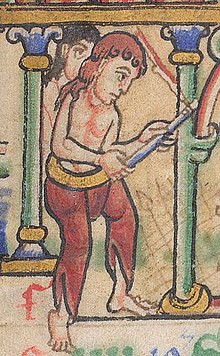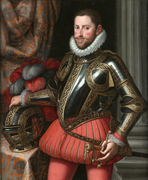Pants
The trousers is a garment that fits at the waist and reaches a variable height of the leg or up to the ankles, covering each leg separately. It generally consists of two legs.
Features
This fabric made of different materials (cotton, denim, polyester, corduroy, etc.) has three openings; one of them fits at the waist and the other two on each of the legs. The pants can be long, in which case the leg openings reach the ankles or even lower, or they can be short in different graduations, ranging from the calf (pirates) to the knee (trousers) or the knee. groin (mini-short). When the length reaches mid-calf, they are called Capri pants.
This garment is worn by both men and women, and usually also has accessories such as pockets to store personal items, a zipper (fly in the case of men), to more easily dress those made of less flexible materials, and belt loops, to be able to hold belts, in those that are loose at the waist.
Etymology
The word «trousers» comes from Pantaleon, literary archetype of the bourgeois of the XVII century typical of the Italian comedy of art and that he was wearing a garment of this type.
History
Prehistory
In the Upper Paleolithic there are indications that trousers were worn, as seen in the figurines found in the Siberian sites of the Mal'ta and Buret' culture. The fabrics and the technology for their construction are Brittle and easily disintegrate, they are often not found among the artifacts discovered at archaeological sites. The oldest known pants were found in the Yanghai cemetery, taken from mummies from Turfan, Xinjiang, in western China, belonging to the peoples of the Tarim Basin; dated to the period between the XIII and the X to. C. and made of wool, the pants had straight legs and a wide crotch, and were probably made for horse riding.
Antiquity
The Greeks did not wear them, as we see from two passages in Theophrastus. We find in Ovid some verses in which he expressly says that this barbarian adornment or coat was unknown to the Greeks and reproaches the inhabitants of Pontus, who boasted of being Greek by origin, for having adopted the pants of the Persians. their deadly enemies. Only the athletes wore a girdle or waist area to cover their nakedness. It resembled a closed apron or apron, the Roman country style and the subligaculum, which was actually the same thing.
The Trojans, the Phrygians, the inhabitants of the Taurica and, in a word, all the barbarians appear on the Greek monuments with breeches similar to our pants, but longer and more wrinkled. The Gauls distinguished themselves with that part of their dress called by the Latins bracece, which led to the name of a part of the Gauls gallia braccata (bragada).
In early Roman times breeches were not worn, because the tunic reached to the knees and the toga to mid-calf. These were replaced when carrying weapons or fearing the cold with certain bandages, fascice crurales, with which the thighs were wrapped. But later, after the Gauls, the Germans and the Goths had mixed with the Romans, the latter generally adopted the long trousers of the former.
From a passage in Trebelio it turns out that the soldiers also wore a campestre. Officers are depicted on different ancient monuments wearing breeches that reach to the knee or slightly below.
All those who went out to the theaters of Rome were obliged to wear long breeches out of decency, as seen by Cicero and other monuments of Antiquity. Ordinarily in public baths the country or the subligaculum was worn, as can be seen from some verses by Marcial.
Gallery
Contenido relacionado
Peralejos from above
Reus
Folklore and customs of Lambayeque




















